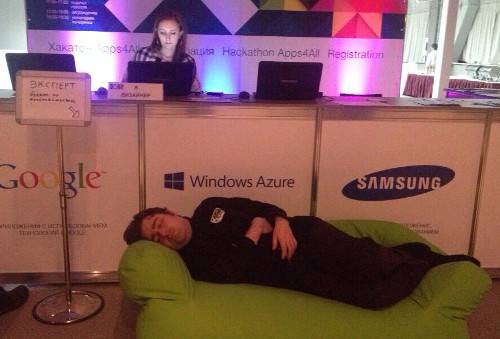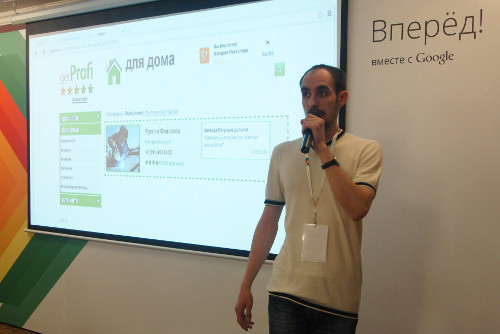How are hackathons? And a week before PayPal BattleHack 2014 Moscow
Over the past couple of years I have spent a large number of hackathons as a hobby. In general, the Internet already has a lot of information about how such events are held, the impressions of the participants and the stories of the organizers are posted. Nevertheless, in the case of personal agitation of developers and designers on the offer “Come, it will be cool!” I overwhelmingly get the questions “What is it?” And “What should I do there?”. In just a week, one of the largest European hackathons starts in Moscow - PayPal BattleHack, whose information partner is Mail.Ru Group, and under the cut you can read about how hackathons look from the inside by the presenter.
This is not true. Hackathon is primarily a rave event, whose main objectives are:
As you can see, hackathons do not have the goal of "luring and poaching a megarazrabotchika." The entrance is open to all, and the more people try their hand, the better for all participants of the event.
')
Hackathon begins with the fact that everyone gathers in a large hall, where sponsors and organizers solemnly open the event. Then the presenter tells how everything will pass, and begins one by one to invite the authors of ideas to the stage, who talk about their idea within a minute, as well as about who they have in the team and who they need:

After all the authors have come forward, the process of team building begins. To simplify it, the presenter, as a rule, numbers the teams and, during speeches, writes a short synopsis on the flipchart sheets, which he then hangs around the hall. Developers, designers and their sympathizers go from sheet to sheet, the numbers find the authors of the projects they like, discuss technical details and form teams. Here we are interested in two points:
After half an hour, with difficulty gathering everyone back, the presenter once again tells what will happen next, and gives the go-ahead to the beginning of the development. Hackatons are usually held in business centers or large good co-working rooms, where there is plenty of space, tables, sockets and good Wi-Fi. For example, coworking in Nagatino, where I often spend hackathons, looks like this:


Next on schedule usually starts lunch. Half an hour after lunch, the presenter takes a mighty handful of experts and begins to go around the teams. They communicate with each team, answer questions and draw promises from them to make a minimally working version by night. After that, the guys and girls are left for five hours alone, while they code for their pleasure.
Closer to the night the leader makes a second round of the teams and looks at what they did. It turns out different: someone already has everything working, someone enthusiastically saws user authorization, someone traditionally has a “universal framework for just a little bit to finish, and then it’s us!” Having assessed the degree of damage, the moderator tells where it makes sense to move on, and leaves the guys for the night. Usually most hackathons are 24-hour, and most teams work all night. The organizers provide ottomans / sleeping bags for those who have gone from a distance to sleep, and some of the teams go home at night:

On the morning of the second day, the most interesting begins, called the unpleasant English word pre-pitch - the training session. From each team on a stage 2 participants are invited in turn, one of whom gets acquainted with the equipment for carrying out the project presentation, and the second trains from the stage to sell to the leader results of the work. Having trained and received valuable recommendations, the teams are removed to refine and improve the project.
In the middle (or at the end, as it will) of the second day, the participants proceed to the project presentation. The press, sponsors, all are seated in a large hall, and the teams take turns on the stage to convince the jury that what they did is the coolest in the whole hackathon, and it is they who need to present the prize. Laptops are connected to the projector, mobile devices are placed under a special document camera, which transmits an image of the table and the device lying on it to the projector. Usually each team is given 3 minutes to speak and the jury questions:

And finally, after the performance of all the teams, the jury heroically distributes prizes. The organizers solemnly award everybody, after which they arrange another unpleasant English word - afterparty.
Who needs all this
One of the misconceptions about hackathons is to assume that this is something “like a programming olympiad for cool programmers with 20+ years of specific experience that Google and Microsoft will hunt right away on the hackathon”.This is not true. Hackathon is primarily a rave event, whose main objectives are:
- Get more people involved in developing your own solutions. Despite the fact that many participants of the hackathon have solid experience in developing large companies, it is at such events that they can try to do something of their own in conditions close to the fighting ones.
- Provide opportunity to novice developers and experts to communicate with each other. This allows the first to know about the current state of the industry, and the second about the trends among young people. And experts are often much more important than the developers themselves, because in this way they can learn first-hand about what the younger generation is breathing now and what difficulties they face.
- Promotion of the development. It is not enough good developers, and on a bed they do not grow. The task of large IT companies is not only to row up the best ones in the market, but also to ensure that in 5-10 years the next generation of programmers will appear. Desirable better than the current :). And since with higher education for developers, everything is still sad, we have to take a set of measures, starting with opening our own institutions and ending with hackathons.
As you can see, hackathons do not have the goal of "luring and poaching a megarazrabotchika." The entrance is open to all, and the more people try their hand, the better for all participants of the event.
Who comes to the hackathons
Over the last ten hackathons conducted, a good sample was gathered, on the basis of which the following conclusions can be drawn:- Usually involved from 60 to 120 people, rarely more or less.
- The age of participants is evenly distributed between 16 and 50 :).
- Developers are mostly beginners and intermediate level, “bison” with 10+ years of experience are usually less than a dozen.
- Developers and designers are always lacking. Over the past year, I have never had a situation so that there is no team that would desperately need any developer or designer. And a lot of situations where the authors of ideas could not find developers and strengthened other teams, instead of embodying their idea.
How is hackathon
Of course, all hakatony different. But in general, there are many common points.')
Hackathon begins with the fact that everyone gathers in a large hall, where sponsors and organizers solemnly open the event. Then the presenter tells how everything will pass, and begins one by one to invite the authors of ideas to the stage, who talk about their idea within a minute, as well as about who they have in the team and who they need:

After all the authors have come forward, the process of team building begins. To simplify it, the presenter, as a rule, numbers the teams and, during speeches, writes a short synopsis on the flipchart sheets, which he then hangs around the hall. Developers, designers and their sympathizers go from sheet to sheet, the numbers find the authors of the projects they like, discuss technical details and form teams. Here we are interested in two points:
- Usually half of those who came to the hackathon are already assembled teams, but often without a programmer or designer. The second half - the authors of ideas without a team (who are often programmers or designers) and developers and designers themselves.
- Primary team building is not forever. Usually, a few hours after the start of work, some of the teams are reformed once again: ideas are reinterpreted, and large teams fall apart, and small ones, on the contrary, unite with each other.
After half an hour, with difficulty gathering everyone back, the presenter once again tells what will happen next, and gives the go-ahead to the beginning of the development. Hackatons are usually held in business centers or large good co-working rooms, where there is plenty of space, tables, sockets and good Wi-Fi. For example, coworking in Nagatino, where I often spend hackathons, looks like this:


Next on schedule usually starts lunch. Half an hour after lunch, the presenter takes a mighty handful of experts and begins to go around the teams. They communicate with each team, answer questions and draw promises from them to make a minimally working version by night. After that, the guys and girls are left for five hours alone, while they code for their pleasure.
Closer to the night the leader makes a second round of the teams and looks at what they did. It turns out different: someone already has everything working, someone enthusiastically saws user authorization, someone traditionally has a “universal framework for just a little bit to finish, and then it’s us!” Having assessed the degree of damage, the moderator tells where it makes sense to move on, and leaves the guys for the night. Usually most hackathons are 24-hour, and most teams work all night. The organizers provide ottomans / sleeping bags for those who have gone from a distance to sleep, and some of the teams go home at night:

On the morning of the second day, the most interesting begins, called the unpleasant English word pre-pitch - the training session. From each team on a stage 2 participants are invited in turn, one of whom gets acquainted with the equipment for carrying out the project presentation, and the second trains from the stage to sell to the leader results of the work. Having trained and received valuable recommendations, the teams are removed to refine and improve the project.
In the middle (or at the end, as it will) of the second day, the participants proceed to the project presentation. The press, sponsors, all are seated in a large hall, and the teams take turns on the stage to convince the jury that what they did is the coolest in the whole hackathon, and it is they who need to present the prize. Laptops are connected to the projector, mobile devices are placed under a special document camera, which transmits an image of the table and the device lying on it to the projector. Usually each team is given 3 minutes to speak and the jury questions:

And finally, after the performance of all the teams, the jury heroically distributes prizes. The organizers solemnly award everybody, after which they arrange another unpleasant English word - afterparty.
Just a week later
The organizers of BattleHack have released the last batch of tickets (of course, free), and you still have the opportunity to participate. I can answer the questions in the comments.Source: https://habr.com/ru/post/240455/
All Articles